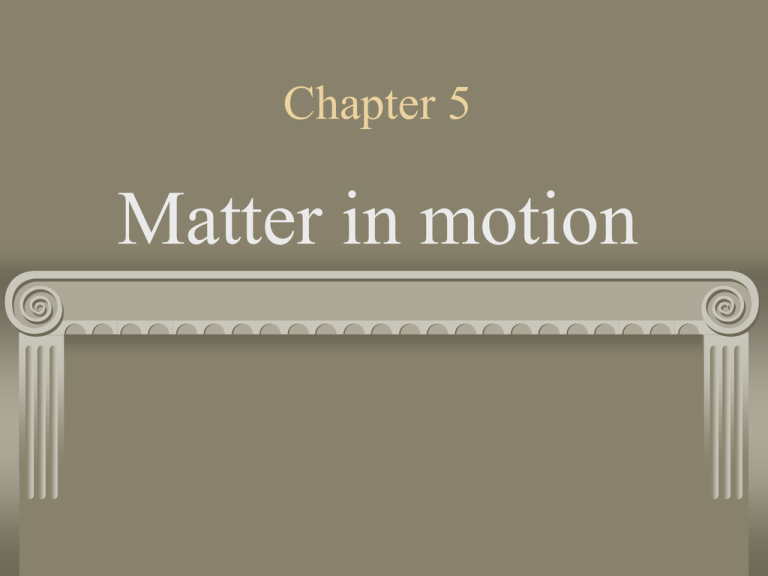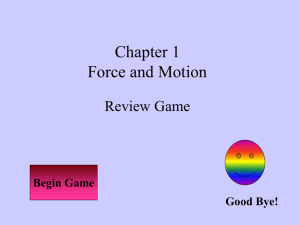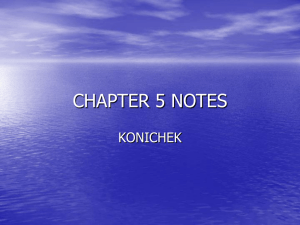Chapter 5 power point
advertisement

Chapter 5 Matter in motion I. Measuring Motion A. Motion- Motion occurs when an object changes position over time when compared to a reference point. www.speedski.com/ carolyncurl.htm I. Measuring Motion 1.Common reference points include the earth, buildings, trees, etc. 2. Moving objects can be reference points. capricorn.woot.net/ ~sbdep/cs488/ www.biography.ms/ NASCAR.html B. Speed- depends on the distance traveled and the time taken to travel that distance. 1. The SI unit for speed is meters per second (m/s). Other common speed units are km/hr and miles/hr. www.adoptionworld.org/ pip/coloring.html 2. Determining average speed. ( triangle diagram) Speed = distance /time How many different labels for speed can you think of? VIDEO-Science Investigations Physical Science: Investigating Motion, Forces and Energy. Discovery Channel School. 2004. unitedstreaming. 1 March 2006 <http://www.unitedstreaming.com/> Speed practice problems 1. What is your average speed if you take 0.5 hours to walk 4000 m? 4000m/0.5h= 8000m/hr 2. The average speed of a car is 110km/h how long will it take the car to travel 715 km? 715km/110km/h= 6.5hours 3. if you are traveling at 67km/h for 2.5 hours how far will you go? 67km/h x 2.5h= 167.5km 4. The train traveled 500 kilometers north to Odessa in 2 hours. What is the train’s speed? What is it’s velocity? Distance= 500 Km Time = 2 hours Speed = distance /time Speed = 500km/2h Speed = 250 km/h Velocity = 250 km/h North 5. Jeremie ran around the track at the YMCA for 2 hours. When he was done he figured that he had traveled 20 kilometers. What was his speed? What was his velocity? Distance = 20 km Time = 2 h Speed = distance /time Speed- 20km/2h Speed =10km/h Velocity = 0 ( he traveled in circles so there is no direction. No direction no velocity) Slope helps us to compare information on different graphs. The slope of a distance vs. time graph is equal to the average speed. Slope = rise / run distance vs time 8 6 4 2 0 15 Series1 distance distance distance vs time 10 Series1 5 0 1 2 3 4 time 5 6 1 2 3 4 5 6 time Rise is how far up the graph goes and run is how far over. C. Velocity- Velocity is the speed of an object in a particular direction. 1. Speed and velocity are not the same. Velocity always includes reference direction. http://www.amadirectlink.com/news/2005/speed.asp 2. Constant velocity is always along a straight line. Speed and direction do not change in constant velocity. www.openingbands.com/ reviews/ 3. Velocities can be combined to determine resultant velocity. Martin’s notes on adding velocities.MP4 Speed velocity + acceleration video Basics of physics united streaming .com 4 minutes Ann is at the airport and is in a rush. She normally travels north at 2 m/s. If she gets on a “moving sidewalk “ that travels at 2 m/s north and walks on it, what will be her resultant velocity? 2m/s North + 2 m/s North = 4 m/s North ( same direction means addition) Ann is traveling north. Is it better for Ann to take a place and stand on a north moving sidewalk at 2 m/s or to walk north fast at 3m/s on the empty south “moving sidewalk” that travels at 2m/s? Standing on the north sidewalk is 0m/s you walking and 2m/s N the sidewalk for a total of 2m/s north Walking 3m/s North on the 2m/s south sidewalk is a subtraction problem 3m/sN – 2m/s S= 1 m/s north It is north because that is the bigger number The north moving sidewalk is faster at 2 m/s total D. Acceleration- Acceleration is the rate at which velocity changes. The faster the velocity changes, the greater the acceleration is. www.mouvup.com/.../ fr/demo/demoAcceleration.html VIDEO-Science Investigations Physical Science: Investigating Motion, Forces and Energy. Discovery Channel School. 2004. unitedstreaming. 1 March 2006 <http://www.unitedstreaming.com/> 1. Calculating acceleration: Acceleration = (Final velocity – Starting velocity) (time it takes to change velocity) -ORAcceleration = ∆ v / time to ∆ v VIDEO-Science Investigations Physical Science: Investigating Motion, Forces and Energy. Discovery Channel School. 2004. unitedstreaming. 1 March 2006 <http://www.unitedstreaming.com/> 7. Acceleration would be shown on a velocity vs. time graph. velocity (m/s) velocity vs time 8 6 4 2 0 velocity 1 2 3 4 5 time (s) 6 7 8 9 2. The unit for velocity is m/s and time is s. Acceleration is m/s/s. 3. Positive acceleration occurs when the velocity increases. 4. Negative acceleration (deceleration) occurs when the velocity decreases. 5. A change in direction, without a change in speed, is acceleration also. 6. Circular motion is continuous acceleration. a. Standing on the equator of the earth or a windmill b. Circular motion is known as centripetal acceleration. id.mind.net/.../ circularMotion.html Extra practice on velocity and acceleration problems Jose travels 275 meters in 15 seconds. What speed is he traveling at? 275/15 = 18.3m/s 2. How far will Jose have traveled in 5 seconds? In ten seconds? 18.3 x5 = 91.5 3.Marta travels to Iowa city at 89 kilometers per hour. It will take her 1 hour and 5 minutes to get to Iowa City. How far away is it? 89X 1.08 = 96.12 1. 4. Mrs. Martin lives 20.93 Km from school. It takes her 25 minutes to get to school. If the speed limit is 55 km/hr is she speeding? No , she is traveling at 49.8 km/h 25/60 to get hours = 0.42 distance/time 20.93/.42=49.8 5.Indiana Jones is on top of a truck traveling at 130 m/s. if he crawls along the top of the truck to the front of it at 3 m/s what is his total velocity? 133m/s forward 6. If Indiana Jones falls under the truck and uses his whip to control his speed under the truck as he moves back to the back of the truck at 5m/s what is his total velocity? 125m/s forward 7.Janice is walking her big dog at a rate of 2 m/s. The dog sees a rabbit and drags Janice up to the speed of 10 m/s in three seconds what was her acceleration. (10-2) / 3= 2.7m/s/s 8. Janice give the command to stop and her dog does in 4 seconds. What was her acceleration. (0-10) / 4 = - 2.5m/s/s Why is it negative? Because she is slowing down II. What is Force? A. Force- A force is a push or a pull. www.qconline.com/ progress98/ee/prtug.html personal.stevens.edu/ ~mparagan/homepictures.htm PUSH! PULL! www.llamas.co.nz/fun.html Video Push Pull - Things in motion. Visual Learning Company (2004). Retrieved March 1, 2006, from unitedstreaming: http://www.unitedstreaming.com/ 1. Forces have size and direction. 2. Forces are everywhere. If you see something moving, a force caused the motion. 3. Newton- Forces are expressed using a unit called the Newton (N). 4. The more Newtons, the greater the force. Sir Isaac Newton (1642-1727). Source: IRC Copyright: 2005 B. Net Force- Net force is the force that results from combining all the forces exerted on an object. 1. Forces in the same direction are added together to find net force. 2. If opposing forces are in play, net force is determined by subtracting the smaller force from the larger one. C. The net force on an object tells whether the forces on the object are balanced or unbalanced. 1. Unbalanced forces produce a change in motion. (acceleration) a. When the net force is not zero, the forces are unbalanced. b. Unbalanced forces are necessary to cause a non-moving object to produce a change in motion. www.softwarereality.com/ lifecycle/role_fragme... 2. Balanced forces produce no movement. a. When the net force is equal to zero, forces are balanced. b. A house of cards has balanced forces or….! www.toxiccustard.com/ cards/ III. Friction: A Force that Opposes Motion A. Friction- Friction is a force that opposed motion between two surfaces that are touching. http://www.school-forchampions.com/science/friction.htm VIDEO-United streaming .com friction 1:33 B. Friction occurs because the surface of objects is rough. 1. Even objects that feel smooth have microscopic “hills and valleys”. http://ffden2.phys.uaf.edu/211_fall2002.web.dir/Ben_Towns end/StaticandKineticFriction.htm 2. Friction between two surfaces depends on the roughness and force pushing the surfaces together. 3. Rougher surfaces create more friction, smoother surfaces create less. 4. The greater the force pushing two objects together, the greater the friction between the two surfaces. C. There are many types of friction. 1. Sliding friction. Sledding, Brakes on a Bike, Writing with a pencil. http://www.darvill.clara.net/enforcemot/friction.htm 2. Rolling friction. Anything with wheels. http://www.school-for-champions.com/science/friction.htm 3. Fluid friction. Opposes the motion of objects through liquid or gas. http://www.darvill.clara.net/enforcemot/friction.htm 4. Static friction. Force applied to an object but does not move object. D. Friction can be helpful or harmful. 1. List helpful and harmful friction affecting a moving car. 2. Friction can be reduced between objects. a. Lubricants- reduce friction between objects. (motor oil, grease) http://www.darvill.clara.net/enforcemot/friction.htm b. Ball bearings- reduce friction between wheels and axles. http://science.howstuffworks.com/bearing3.htm Inline skates & skateboards Conveyer belt rollers Stools and Lazy Susan turntables c. Sanding/smoothing objects to lessen the “hills”. woodstore.woodmall.com/ is16fe20.html 3. Friction can be increased between objects. a. Rough up a surface- Sand on icy road. www.superiorspecialty.com/. ../Incom/GritE.html b. Increase the force between objects- Paper weight, Scrubbing. IV. Gravity: A Force of Attraction (P. 125-129) • A. Gravity- Gravity is a force of attraction between objects due to their masses. (Demo TE125) B. All matter is affected by gravity. 1. All matter has mass. Gravity is a result of mass. Therefore all matter experiences gravity. 2. Gravitational force pulls objects toward each other. 3. The Earth’s gravity is so large it affects everything on the Earth. C. Law of Universal Gravitation states that all objects in the universe attract each other through gravitational force. The size of the force depends on the masses of the objects and the distance between them. VIDEO- Basics of Physics: Exploring Gravity. United Learning (2004). Retrieved March 1, 2006, from unitedstreaming: http://www.unitedstreaming.com/ 1. The moon has less mass than the Earth. You would only weigh 1/6 as much on the moon! 2. Gravitational force decreases as distance increases. D. Weight- Weight is a measure of gravitational force exerted on an object. 1. Weight is expressed in the unit, newtons (N). 2. Weight and mass are different. Weight is the result of gravity pulling on a given mass. Mass- Mass is the amount of matter in an object. United streaming weight vs. mass 57 sec








